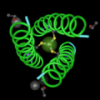Cofactor Genomics is offering to sequence a genome for a few classes for free using Next Generation DNA Sequencing technology (either Illumina GA or via AB SOLiD).
Quoting from their site:
Cofactor will ask course organizers for a 1 page description of how their ~700Mb sequencing project could be used as an effective teaching aid in their class. We will review and choose the best entries during the month of May. Those entries will be awarded a free sequencing project including project experimental design, sample QC, library construction, sequencing, and computational analysis. Those projects will be completed on either our Illumina GAIIx and SOLiD-3 Next-Gen sequencing platforms.
This is an incredible opportunity for a college level course. You can have your genome sequenced and your class can do the annotation as a class project.
Thanks to Keith Robison for getting them inspired.

We did just this for a class this semester at Berkeley (OK - not exactly this - we sequenced a fungal genome, and we did it ourselves). And I have to say it's been the best teaching experience I've had. The students - many of whom had no comp bio/programming experience coming in - have, in a few months, learned how to do all the things one does in assembling, annotating and analyzing a genome. Having something cool and new to work on is so much more inspiring than even the best of canned exercises.
My only suggestion - for people who have access to a next gen sequencer - is to do it yourself and let the students start with the raw reads rather than an assembled genome.
Thanks Micheal,
I agree. There's nothing like working with the information to really get the point across.
Just tweeted your post to the #apbio group on Twitter.
Thanks Gregory,
I think this is a great opportunity.